WEDNESDAY'S SCRIPT TIP:
VISUALS vs. VISUAL STORYTELLING

BLADE RUNNER 2049 is a visually stunning movie that won the American Society Of Cinematographers Best Feature Film Award for Roger Deakins’ amazing work a few days ago, and even though critics generally appreciated it, the film suffered the same fate at the box office as its predecessor. I think it’s a mistake to believe that the sequel to a cult film will do any better business than the original.
I saw the original BLADE RUNNER either on opening night (probably a Wednesday back then) or at least within the opening week of release. I even remember who I saw it with. I thought it had amazing production design but a story so slight and vague that everyone seems to have a different idea of what it’s “really about” and there are dozens, or maybe even hundreds, of fan theories. Since then, I have seen every new cut and new version of the film in a cinema at least once, and it’s nice to finally have Joanna Cassidy’s face superimposed over that stuntman, but the story remains vague and slight, with some great performances adding to the amazing production design and visuals.
The sequel has a more coherent and less vague story, even though it’s completely preposterous; and thanks to CGI and modern digital effects - even more impressive production design and visuals, and that great cinematography by Deakins. It’s a feast for the eyes that really should be seen on a huge screen...
But it still has about 90 minutes of story stretched over an almost 3 hour running time. That may not be a major issue for those of us who can just appreciate it for the amazing eye candy and some pretty good performances, but the general audience seemed to reject it. It was one of the biggest flops of 2017. And how is that a surprise to anyone? The original was one of the biggest flops of 1982. It has a loyal following, but it is still a cult film - and a cult isn’t everyone, it’s a small splinter group. That small splinter group showed up for the new film, but there weren’t enough of them. This is the problem with any sequel or remake of a cult film - people think that everybody loves it because it has lasted this long, but it’s still that small group of mega-fans. So BLADE RUNNER 2049 may end up a mostly unseen film to mainstream audiences, when it really has some stunning visuals to offer.
But what about the title of this Script Tip? What is the difference between Visual Storytelling and Visuals? Is one better than the other? And can one *undermine* the other? I’m so glad you asked! I guarantee this Script Tip will generate hate mail from those of you in the Cult Of Blade Runner...
VISUALS Vs. VISUAL STORYTELLING
SPOILERS!
These are two completely different things which are supposed to work in congress with each other to tell the story.
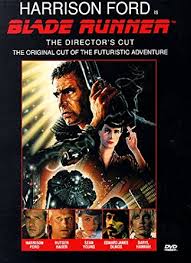
Visual storytelling is using the actions of the characters to tell the story - the way a Buster Keaton silent film does. "Actions" doesn't mean car chases - in fact, cars chasing cars are not really the actions of characters, but the actions of machines. We want to tell the story by having our characters *do things*. Both on a larger story level and on an individual scene level. So K’s story in BLADE RUNNER 2049 is to find the child born of an artificial person. In the opening scene with the huge Protein Farmer, he discovers the bones of a woman who died in childbirth buried on his property, and we later find out these bones belonged to a replicant. The very idea that a replicant could reproduce is earth shattering and “dangerous”, so K’s job is to find the child and terminate it. The search for that child is what drives the story, and that is a *physical* action, ie: visual. We have a mystery and K finds clues along the way, which lead to other clues. So on a story level, there are actions which lead us from scene to scene.
By the way, love the name "K" - it’s Kafkaesque!
The other major visual storytelling element is that wooden horse. The horse is something that we can see, and it becomes a major clue to the child that K seeks. I think it’s interesting that it is a horse, because it is kind of a “trojan horse” - it looks like one thing but is in fact another. This is what I call a “two way clue” that seems to point to one character but secretly points to another character, and once our “primary suspect” is ruled out, we stop thinking of it as a clue for a while... until we realize it also points to a secondary suspect (who is the actual “guilty party” - in this case the actual child of man and machine).
This film also uses casting to help steer us towards suspects: we have one character who looks like the father of the child and one character who looks like the mother of the child, so when the character who resembles the father is removed from the equation the audience naturally jumps to the conclusion that it must be the character who resembles the mother... who happens to be the villain. This makes complete sense, because - SPOILER - the protagonist K resembles Deckard and our antagonist Luv resembles Racheal - are they two sides of the same coin? Is the connection between hero and villain that one is the child and the other is searching to destroy the child? (That works either way.) So, even though casting is mostly out of the control of the screenwriter, here it helps tell the story. That wooden horse is the only real element of visual storytelling that is part of the screenwriter’s job in the film, the rest of it is...
Visuals are "shots" - an amazing image. Though the directors call the shots - and will probably be responsible for most of the visuals in the film, we are responsible for *visual storytelling* and since we select the locations and many of the elements - we have a hand in those *visuals*. And sometimes, without overtly directing on paper or using camera directions, we can create a strong visual moment.

BLADE RUNNER 2049 is filled with amazing Visuals, and the trailer is packed with them. That is the “bait” for this movie - you enter a fully realized amazing world for almost three hours. There are the neon signs and billboards from the original *plus* all kinds of hologram adverts that seems to look right at you. There are rainy crowded streets from the original, as well as disfigured landscapes - trash heaps and whatever is left of Las Vegas. This is a fascinating world to look at. There should e a coffee tale book! As writers, this is where our imagination kicks in, even if we are not writing science fiction. I’ve written about the world of JOHN WICK, and how that creates a unique experience in a crime film. But films like LAWRENCE OF ARABIA and other epics use visuals to create a big screen experience for the viewer. As visual entertainment continues to fracture with streaming and other small screen options there is going to be more importance attached to the type of amazing visuals that are best viewed on a massive cinema screen.
Describing a house or a salt shaker in your script is not a visual. A good visual creates an image that sticks with the viewer long after the house lights are up. It haunts us. Creating an emotional experience without words. Touching us on a subconscious level to give us an experience stronger than the image itself. We want to use our *visuals* sparingly in the screenplay - and only use the most evocative and powerful images. If you spend all of your words describing a salt shaker or a house, you won’t have any left for images that are truly striking, like the ones in BLADE RUNNER 2049.

In mystery writer Michael Connelly's great novel THE CONCRETE BLONDE, a prostitute's body is thrown into a vat of wet concrete. When the murder is discovered many years later, the body has decomposed... except for the silicon modified breasts which are in perfect condition. This image of the wasted body with unnaturally perfect breasts is haunting. It gives us a glimpse of the victim, who put physical attraction above all else. The image is filled with irony and tragedy, infused with emotion. Years after reading the novel, this image comes back to me with perfect clarity. That's good writing. We want to find images like this for our stories, not mundane images that do nothing to affect the viewer. Connelly’s image oddly creates sympathy for the long dead woman. Humanizes her.
Another memorable image comes from Sidney J. Furie and Rick Natkin's under rated Viet Nam War film THE BOYS IN COMPANY C. Stan Shaw plays a loner: A soldier who believes that depending on the other screw-ups in his platoon will get him killed. While patrolling a rice paddy, Shaw steps on a mine. The moment he takes his foot off the mine, it will blow up, killing all of those around him. "Do not go near that man, leave him alone. He is a dead man." All of the other members of the platoon reluctantly move away, leaving Shaw standing alone in the middle of the rice paddy... Waiting to die.
The lone-man image in HIGH NOON, where Gary Cooper steps onto the street, and the camera pulls back to show him alone. The streets deserted. The view of him from high overhead, seeming small and powerless, has haunted viewers since the film's initial release. And that image is *the whole movie in a visual* - the story itself is about one man against the world. It’s not just a striking image, it’s all about story! But does every visual need to be story related? Can’t they just be “cool”?
VISUALS & STORY

The problem with Visuals is that "actions speak louder than words" and "seeing is believing" and many other homilies that tell us "what you see is what you gonna get!" * So even when we are just dealing with visuals, they also need to be telling the story. And this is where both the original BLADE RUNNER and BLADE RUNNER 2049 go off the rails. The original film is filled with amazing visuals... that make no sense. When it first came out, the special effects were amazing, but the story and over-production design aspects were disappointing. As years pass, the FX work (still great) has kind of faded - so many movies these days have *tons* of amazing FX work, that the novelty has worn off. That makes the over-production designed aspects really stick out - the over-the-top wardrobe and hair, the *indoor* rain and mud and filth in a building owned by a genius tech guy who is probably a billionaire. The anti-tech equipment that looked like an antique when the film came out. And just the *lack of logic* behind the production design and costuming. Rachael is dressed, hair styled, and made up to look like a freakin’ Mattel doll, and we’re supposed to be surprised that she’s a replicant? None of the other repicants look and act that fake. Every room is *filled* with dense smoke - even if the characters don’t smoke. There is junk and clutter everywhere - and even a small apartment has a piano! The top scientist dude lives in a dump where it rains indoors and dresses like an escapee from a Village People video. Brion James is wearing a hospital gown when he’s being scanned in the opening scene - but has managed to smuggle in a gun. Um, I don’t want to know how he did that, but if *I* were looking for dangerous replicants who had killed a whole bunch of people, I might have the suspects pass through a metal detector. None of the amazing production value or visuals or even cinematography makes much sense... but it sure is pretty!
Okay, let the hate mail begin!

BLADE RUNNER 2049 makes the same error. When we see those crowded streets in Los Angeles - in some scenes so packed with people that K has difficulty navigating them (yet in others people seem to be able to approach him without issue - like the hookers) this undercuts the reason for replicants. Even though replicants are built to do the jobs that humans will not do, there are obviously so many desprate broke humans on the street that it seems only logical that all of these jobs could actually be filled. The overcrowding element goes against the need for workers. Yes, I know that replicants are only used off-world, but in other science fiction films like OUTLANDER and TOTAL RECALL they have no problem getting humans to get their asses to Mars for a job. Why is it a problem in this story and none of the others? And if there was some modification to replicants - they can breathe some other planet’s atmosphere that would kill human workers, how are they able to survive on Earth? The crowded streets are a visual element that doesn’t hold up to a moment’s thought.
And if there is a *reason* besides environmental reasons to use replicants rather than humans, let’s say cost issues, why isn’t that part of the story? Replicants are talked about as “slave labor” in the film, but with streets that crowded someone has to be willing to do that off-world work. The problem is, we can easily compare this story to today’s reality where farm workers are usually immigrants who do hard work for low wages. Are none of those hundreds of people trying to survive on the streets in BLADE RUNNER 2049 not interested in those jobs? And if they aren’t interested - isn’t that a more interesting story to explore? If minimum wage for humans is so expensive that they have to manufacture artificial people to do these jobs, that’s a much more interesting story than an artificial person giving birth, no matter how often people in the film say it’s a game changer that will bring down society as we know it. It’s like if SOYLENT GREEN focused on a story about a store selling cans of soylent green that were past their “use by” date. Hey, these replicants are past their “use by” date, too! That’s why Blade Runners exist - to eliminate the old replicants. So these crowded streets look great on film, but they undercut the story.

K’s holo-girlfriend is another great visual creation that doesn’t really make any sense. I love that he’s saved up to by the portable holo gizmo so that she is no longer attached to that arm in his apartment, but how does this connect to the story or even explore the theme (whatever that may be)? How is she connected to the replicant baby? The scene where his holo girlfriend hires the hooker so that K can make love to her is great... but it belongs in some other film... maybe a remake of CHERRY 20000. Why does K need a holo-girlfriend when there’s a zillion hookers on the street, at least one of which doesn’t want to screw for a living and might want to live in a nice apartment with K? The more you think about the holo girlfriend the less sense she makes in this story. Cool, but not helping to tell the story.
And why are the holographic adverts in destroyed Las Vegas still running?
Like the holo-girlfriend stolen from CHERRY 2000, I loved the way K gets into Las Vegas buried in sand stolen from A BOY AND HIS DOG. This story steals from the weirdest! But, what does that have to do with the story? How is it connected thematically? How is buried Las Vegas a part of this story? Because it’s buried, like the dead mother of replicant baby? That’s a huge stretch, and doesn’t connect to the actual replicant baby once they are found. This movie is a lot of cool visuals that aren’t really connected to the story. The images are not organic. Instead of beginning with the story and finding visuals like Michael Connolly’s that help tell the story on a deeper level, they are just surface cool. We want to find ways to explore the story itself though images. To use those images in service of the story, not in service of "cool". Hey, they can be cool, too! But anything that isn’t taking us deeper into the story is some form of porn.
EVERY PICTURE TELLS A STORY

Visual Storytelling is actually telling the story through moving pictures rather than words, and Visuals are amazing pictures that leave an impact on the viewer... and also help tell the story.
Compare the rainy neon Los Angeles from both BLADE RUNNER films to when Godfrey Tearle lifts his hand to expose a missing little finger, and we know he's the villain in THE 39 STEPS. Or Jimmy Stewart looking from window to window in the darkness after hearing a scream in REAR WINDOW. Or that windmill in FOREIGN CORRESPONDENT, with it's massive sails which catch the breeze one way, then move in the opposite direction... and tell us that the sails are moving *against* the breeze, so something is weird there.
In fact, I could fill several pages with strong images and sequences from Hitchcock films. From Beaky being pushed off the cliff in SUSPICION to the cigarette lighter just out of reach in the storm drain from STRANGERS ON A TRAIN. Though Hitchcock as a director deserves some credit for putting these images on film, it should be noted that they came directly from the pages of the screenplays. From NORTH BY NORTHWEST:
* * *
EXT. SECLUDED ROAD - A FEW MINUTES LATER
A lovely wooded glen securely hidden from the main
road that cuts through the Black Hills. The Mt. Rushmore
Monument can be seen in the distance through the trees.
Thornhill and Eve regard each other uncertainly as she
starts moving toward him.
In a way, they are meeting for the first time. After
all that Eve has done to Thornhill, and he has said to her,
neither can be certain of the others' true feelings. It
is a time for uneasiness, caution, and tentative probing.
Eventually giving way to what has always been apparent:
the fact that they do like each other more than somewhat.
A moment of silence. They move closer.
***
This is a very strong moment from the film, a purely visual moment, and it began as words on a page written by Ernest Lehman.

In William Goldman's "Adventures In The Screen Trade", he quotes Rosalind Russell as saying, "Do you know what makes a movie work? Moments. Give the audience half a dozen moments that they can remember, and they'll leave the theater happy."
These visual moments, whether they be single images or sequences of images, are one of the most important elements of your screenplay... and often one of the most ignored by screenwriters. Far too many screenwriters believe that the visual part of the film belongs to the director. But the director can only interpret what's on the page. If your script doesn't contain strong visual images which create an emotional response in the audience, the best a director can do is to add a peripheral, unrelated image, which doesn't come from the story or characters. Hollow images which will not emotionally move the audience. You want to create string visuals for your story - but visuals that help to tell the story. When Tearle lifts his hand and it is missing the little finger in THE 39 STEPS we know that he is the villain and our protagonist has allowed himself to be captured - that’s story, but it is also one of the most striking images even put on film.
Film is a collaborative medium, but that collaboration begins with our scripts. If we have not written strong, emotionally charged visuals in our screenplays, it's doubtful that those "moments" necessary for a happy audience will end up in the film. Instead the director or production designer or storyboard artist will create those images, and they may not be the right ones to tell the story. Story is our job. I have no idea whether those images were in BLADE RUNNER or BLADE RUNNER 2049's screenplays, but they seem to undercut the story in both films - making them beautiful to look at, but unlikely to draw a larger crowd to the cinema the way TOTAL RECALL and other more story-based science fiction films did.
The success of your screenplay hinges not only on plotting, characterization, and dialogue; but on your ability to create strong visuals which haunt the audience long after the house lights have removed the shadows from the screen. Visual "moments" which touch a chord with the viewer. A half dozen of those moments, and you've got yourself a movie... which will move the audience.
* Flip Wilson, if you were wondering.
BRAND NEW!
How Do I do That?

101 SCREENWRITING ANSWERS Blue Book!
New to screenwriting? You probably have questions! How do I get an Agent? How do I write a phone conversation? Do I need a Mentor? What’s does VO and OC and OS mean? What is proper screenplay format? Should I use a pen name? Do I need to movie to Hollywood? What’s the difference between a Producer and a Production Manager, and which should I sell my script to? How do I write a Text Message? Should I Copyright or WGA register my script? Can I Direct or Star? How do I write an Improvised scene? Overcoming Writer’s Block? How do I write a Sex Scene? And many many more! This book has the answers to the 101 Most Asked Questions from new screenwriters! Everything you need to know to begin writing your screenplay!
All of the answers you need to know, from a working professional screenwriter with 20 produced films and a new movie made for a major streaming service in 2023!
Only $4.99
NEW!!!
Can You Make It bigger?

BLOCKBUSTERS (and BEACH READS) Blue Book!
Writing something EPIC?
ONLY: $4.99!
Thinking about writing a big Disaster Movie? An Historical Epic? An Epic Adventure Film? Or maybe you like Gladiator Movies? This book looks at writing Blockbusters and those Big Fat Beach Read novels - anything epic! Usng movies like JAWS, POSEIDON ADVENTURE, LAWRENCE OF ARABIA, THE GUNS OF NAVARONE, and those MARVEL and FAST & FURIOUS flicks as examples. What *is* a Blockbuster? 107 years of Blockbuster history! Blockbuster Characters. Blockbuster Story Types! Why modern Blockbusters are soap operas! Social Issues in Blcokbusters? Big Emotions! Keeping All Of Those Characters Distinctive! How to avoid the Big problems found in Big Movies and books! More! If you are writing a Big Event Movie or a Big Fat Novel, there are tips and techniques to help you!
Only $4.99
BRAND NEW!
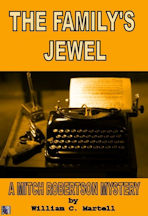
***
MITCH ROBERTSON #2: THE FAMILY'S JEWEL *** - For Kindle!
"The Presidential Suite of the Hollywood Hoover Hotel looked like a bloody battlefield: bodies everywhere, furniture broken, red liquid dripping from the walls, dead soldiers littering the elegant Berber rug as clouds of smoke overhead bounced between two air conditioning vents.
Mitch Robertson stepped over the body of an ex-child star turned sex tape star turned pop star and entered the room, spotted a gun on the floor and picked it up... careful not to spill his coffee with three pumps of mocha syrup from Penny’s Coffee Shop. That coffee was gold, the only thing keeping him going in this dazed state of wakefulness. The gun felt light. Holding it, he saw the silhouette of an 80s action star sitting sideways on a tipped over chair. Motionless. Was he dead? Mitch was still hung over from the Awards Party the night before, and wondered whether this was all some sort of crazy nightmare that he would wake up from... but when he tripped over the brown legs of a bottomless Superhero, flaccid junk encased in a condom but still wearing his mask, and hit the edge of the sofa, gun skittering and coffee spilling, he realized that it was all very real. What the hell had happened here?"
Short Novel. Only 99 cents - and no postage!
IT'S NEW!!
All About Rewrites!
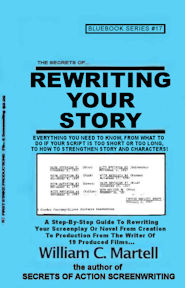
REWRITES Blue Book!
Rewriting In Waves?
When You Finish Your Screenplay Or Novel...
The Rewrites Begin!
The end is just the beginning! You’ve finished your story, but now the rewriting begins! This 405 page book shows you how to rewrite your screenplay or novel to perfection. Everything from Character Consistency to Shoeboxing to How To Give And Receive Notes to 15 Solutions If Your Script’s Too Long! and 15 Solutions If Your Script’s Too Short! to Finding The Cause Of A Story Problem to Good Notes Vs. Bad Notes to Finding Beta Readers to Avoiding Predictability to Learning To Be Objective About Your Work to Script Killer Notes and Notes From Idiots to Production Rewrites and What The Page Colors Mean? and a Complete Rewrite Checklist! The complete book on Rewriting Your Story!
Only: $4.99
HITCHCOCK FOR WRITERS!
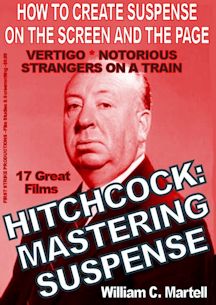
LEARN SUSPENSE FROM THE MASTER!
*** HITCHCOCK: MASTERING SUSPENSE *** - For Kindle!
Alfred Hitchcock, who directed 52 movies, was known as the *Master Of Suspense*; but what exactly is suspense and how can *we* master it? How does suspense work? How can *we* create “Hitchcockian” suspense scenes in our screenplays, novels, stories and films?
This book uses seventeen of Hitchcock’s films to show the difference between suspense and surprise, how to use “focus objects” to create suspense, the 20 iconic suspense scenes and situations, how plot twists work, using secrets for suspense, how to use Dread (the cousin of suspense) in horror stories, and dozens of other amazing storytelling lessons. From classics like “Strangers On A Train” and “The Birds” and “Vertigo” and “To Catch A Thief” to older films from the British period like “The 39 Steps” and “The Man Who Knew Too Much” to his hits from the silent era like “The Lodger” (about Jack The Ripper), we’ll look at all of the techniques to create suspense!
Only $5.99
NO KINDLE REQUIRED! Get the *free* app (any device, except your Mr. Coffee) on the order page on Amazon!
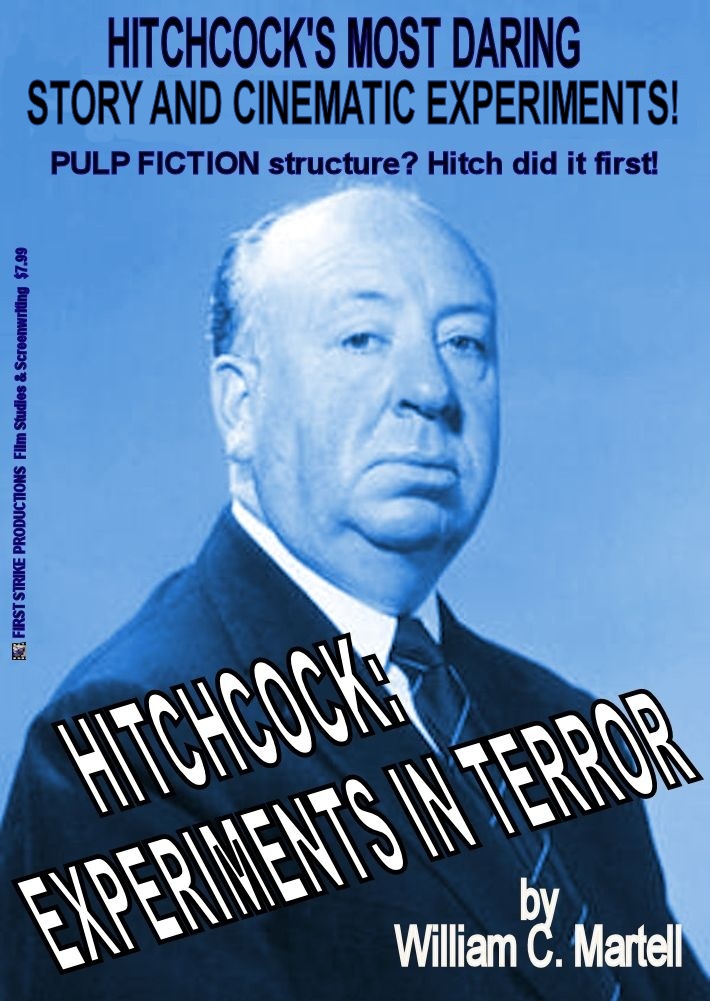
Strange Structures!
*** HITCHCOCK: EXPERIMENTS IN TERROR! *** - For Kindle!
***
Contained Thrillers like "Buried"? Serial Protagonists like "Place Beyond The Pines"? Multiple Connecting Stories like "Pulp Fiction"? Same Story Multiple Times like "Run, Lola, Run"?
HITCHCOCK DID IT FIRST!
This book focuses on 18 of Hitchcock's 52 films with wild cinema and story experiments which paved the way for modern films. Almost one hundred different experiments that you may think are recent cinema or story inventions... but some date back to Hitchcock's *silent* films! We'll examine these experiments and how they work. Great for film makers, screenwriters, film fans, producers and directors.
Only $5.99 - and no postage!
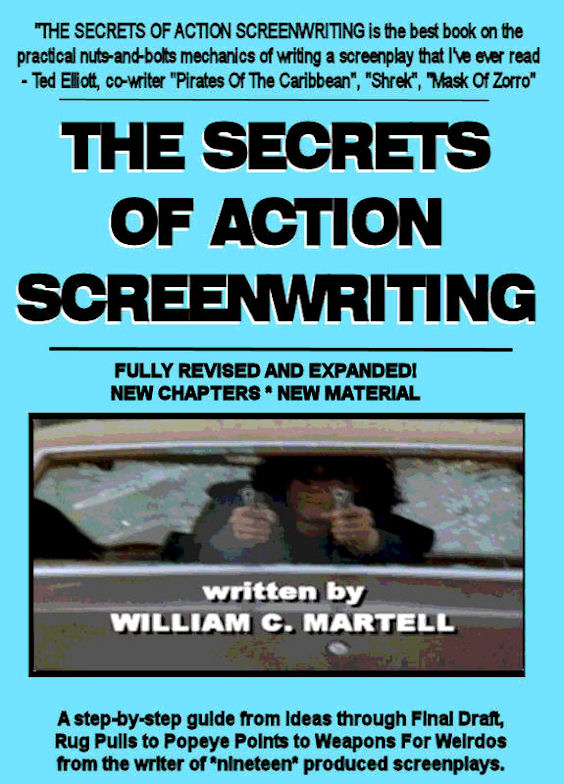
MAKES A GREAT GIFT!
*** THE SECRETS OF ACTION SCREENWRITING *** - For Kindle!
*** THE SECRETS OF ACTION SCREENWRITING *** - For Nook!
Why pay $510 for a used version of the 240 page 2000 version that used to retail for $21.95? (check it out!) when
you can get the NEW EXPANDED VERSION - over 500 pages - for just $9.99? New chapters, New examples, New techniques!
"SECRETS OF ACTION SCREENWRITING is the
best book on the practical nuts-and-bolts mechanics of writing a screenplay I've ever read."
- Ted Elliott, co-writer of MASK OF ZORRO, SHREK, PIRATES OF THE CARIBBEAN and the sequels (with Terry Rossio). (ie; 4 of the top 20 Box Office Hits Of ALL TIME.)
Only $9.99 - and no postage!
Tip FAQ

My New Script Secrets Newsletter!

STORY IN ACTION SERIES!

THE MISSION IMPOSSIBLE MOVIES
NEW: Updates On Films 7 & 8 Casting!
All Six Movies analyzed! All of the mission tapes, all of the “that’s impossible!” set pieces and stunts, the cons and capers - and how these scenes work, the twists and double crosses, the tension and suspense (and how to generate it), the concept of each film as a stand alone with a different director calling the shots (broken in the sixth film), the gadgets, the masks, the stories, the co-stars and team members (one team member has been in every film), the stunts Tom Cruise actually did (and the ones he didn’t), and so much more! Over 120,000 words of fun info!
THE MISSION IMPOSSIBLE MOVIES - 347 Pages - Only $3.99 !

BRAND NEW!
*** THE BOURNE MOVIES
NEW: Updates on TREADSTONE TV show!
All five "Bourne" movies (including "Legacy" and it's potential sequels) - what are the techniques used to keep the characters and scenes exciting and involving? Reinventing the thriller genre...
or following the "formula"? Five films - each with an interesting experiment! A detailed analysis of each
of the films, the way these thrillers work... as well as a complete list of box office and critical
statistics for each film. This book is great for writers, directors, and just fans of the series.
Only $3.99 - and no postage!
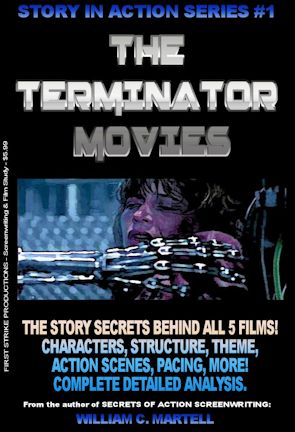
Over 240 pages!
*** THE TERMINATOR MOVIES *** - For Kindle!
He's back! The release of "Terminator: Dark Fate" is set to begin a new trilogy in
the Terminator story... 35 years after the first film was released. What draws us to these films about
a cybernetic organism from the future sent back in time? Why is there a new proposed trilogy every few
years? This book looks at all five Terminator movies from a story standpoint - what makes them work
(or not)? What are the techniques used to keep the characters and scenes exciting and involving? How
about those secret story details you may not have noticed? Containing a detailed analysis of each of
the five films so far, this book delves into the way these stories work... as well as a complete list of
box office and critical statistics for each film. This book is great for writers, directors, and just
fans of the series.
ONLY $3.99 - and no postage!
NO KINDLE REQUIRED! Get the *free* app (any device, except your Mr. Coffee) on the order page on Amazon!

NEW BUT OLD!
*** VINTAGE #1: HOW TO WRITE PHOTOPLAYS *** - For Kindle!
***
Screenwriting books have been around as long as films have. This series reprints vintage screenwriting books with a new introduction and history, plus new articles which look at how these lessons from almost 100 years ago apply to today’s screenplays. Anita Loos book is filled with information which still applies.
In addition to the full text of the original book, you get the full screenplay to Miss Loos' hit THE LOVE EXPERT, plus several new articles on the time period and women in Hollywood.
Only $2.99 - and no postage!
THE BLUE BOOKS!
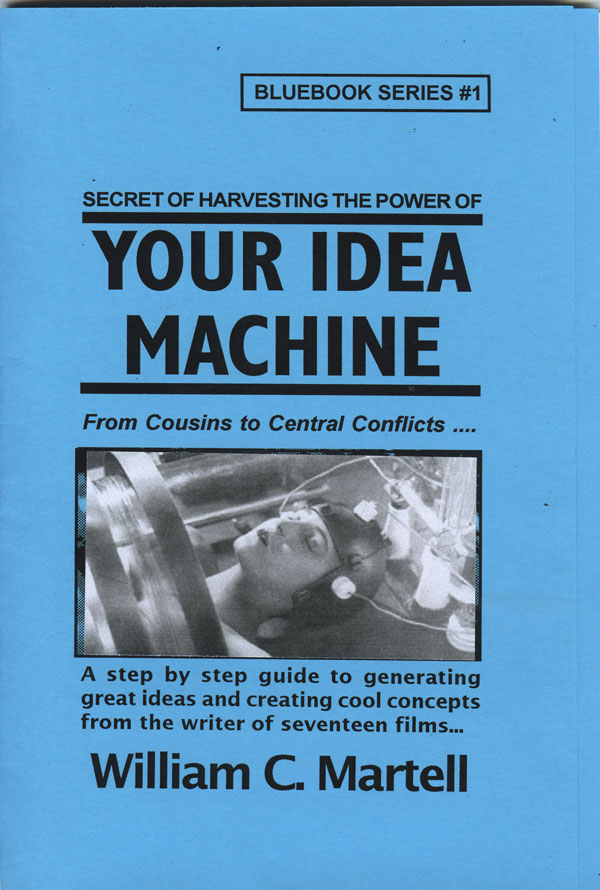
FIND A GREAT IDEA!
*** YOUR IDEA MACHINE *** - For Kindle!
****
Expanded version with more ways to find great ideas! Your screenplay is going to begin with an idea. There are good ideas and bad ideas and commercial ideas and personal ideas. But where do you find ideas in the first place? This handbook explores different methods for finding or generating ideas, and combining those ideas into concepts that sell. The Idea Bank, Fifteen Places To Find Ideas, Good Ideas And Bad Ideas, Ideas From Locations And Elements, Keeping Track Of Your Ideas, Idea Theft - What Can You Do? Weird Ways To Connect Ideas, Combing Ideas To Create Concepts, High Concepts - What Are They? Creating The Killer Concept, Substitution - Lion Tamers & Hitmen, Creating Blockbuster Concepts, Magnification And The Matrix, Conflict Within Concept, Concepts With Visual Conflict, Avoiding Episodic Concepts, much more! Print version is 48 pages, Kindle version is over 175 pages!
Only $4.99 - and no postage!
FIGURE OUT YOUR STORY!
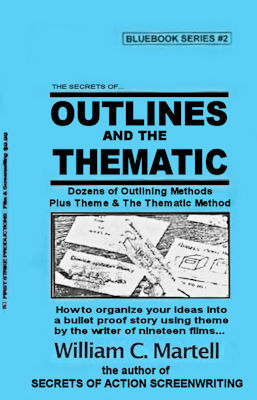
OUTLINES & THE THEMATIC Blue Book.
ARE YOUR SCENES IN THE RIGHT ORDER?
AND ARE THEY THE RIGHT SCENES?
Your story is like a road trip... but where are you going? What's the best route to get there? What are the best sights to see along the way? Just as you plan a vacation instead of just jump in the car and start driving, it's a good idea to plan your story. An artist does sketches before breaking out the oils, so why shouldn't a writer do the same? This Blue Book looks at various outlining methods used by professional screenwriters like Wesley Strick, Paul Schrader, John August, and others... as well as a guest chapter on novel outlines. Plus a whole section on the Thematic Method of generating scenes and characters and other elements that will be part of your outline. The three stages of writing are: Pre-writing, Writing, and Rewriting... this book looks at that first stage and how to use it to improve your screenplays and novels.
Only $4.99 - and no postage!
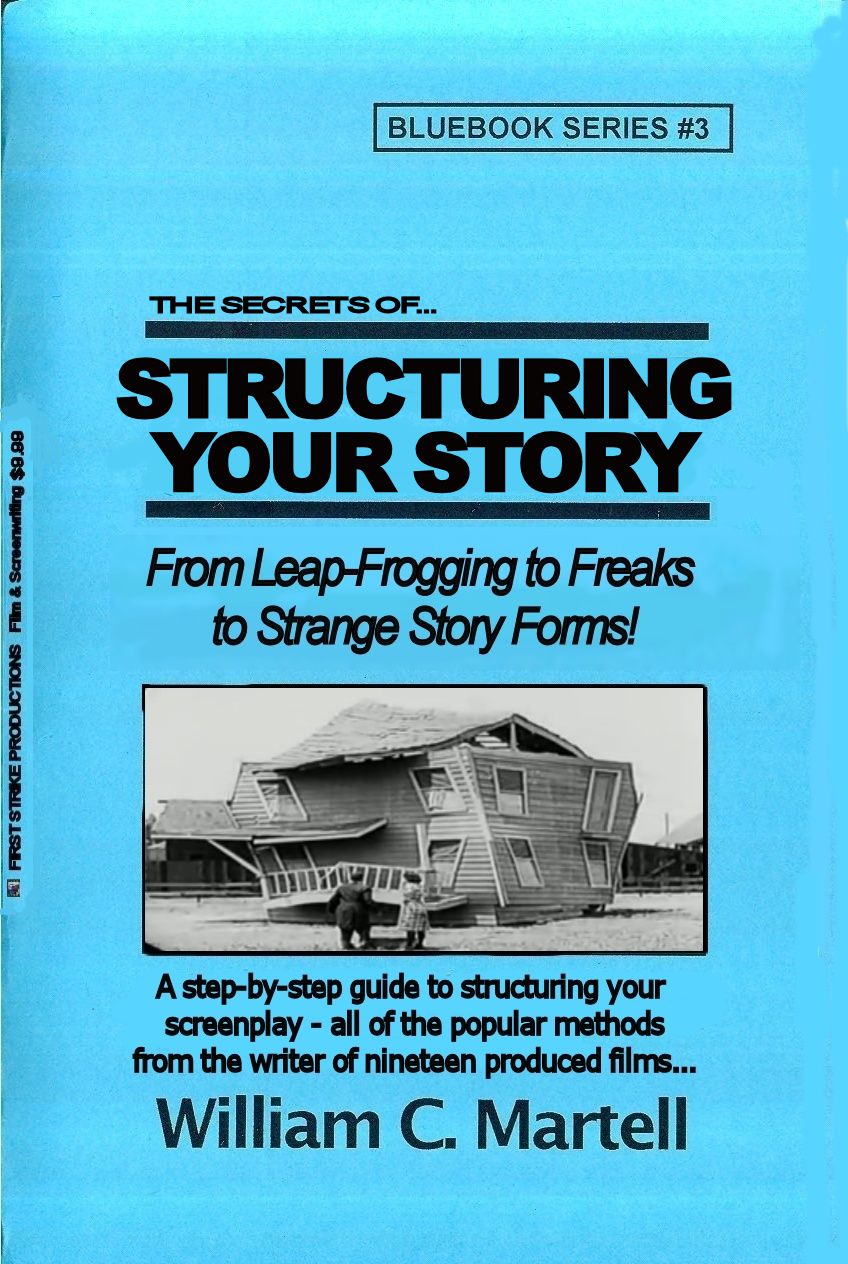
GOT STRUCTURE?!
*** STRUCTURING YOUR STORY *** - For Kindle!
William Goldman says the most important single element of any screenplay is structure. It’s the skeleton under the flesh and blood of your story. Without it, you have a spineless, formless, mess... a slug! How do you make sure your structure is strong enough to support your story? How do you prevent your story from becoming a slug? This Blue Book explores different types of popular structures from the basic three act structure to more obscure methods like leap-frogging. We also look at structure as a verb as well as a noun, and techniques for structuring your story for maximum emotional impact. Most of the other books just look at *structure* and ignore the art of *structuring* your story. Techniques to make your story a page turner... instead of a slug!
Only $4.99 - and no postage!

STORY: WELL TOLD!
*** STORY: WELL TOLD *** - For Kindle!
This book takes you step-by-step through the construction of a story... and how to tell a story well, why Story always starts with character... but ISN'T character, Breaking Your Story, Irony, Planting Information, Evolving Story, Leaving No Dramatic Stone Unturned, The Three Greek Unities, The Importance Of Stakes, The Thematic Method, and how to create personal stories with blockbuster potential. Ready to tell a story?
Print version was 48 pages, Kindle version is over 85,000 words - 251 pages!
Only $4.99 - and no postage!

START STRONG!
*** HOOK 'EM IN TEN *** - For Kindle!
Your story doesn't get a second chance to make a great first impression, and this book shows you a
bunch of techniques on how to do that. From the 12 Basic Ways To Begin Your Story, to the 3 Stars Of
Your First Scene (at least one must be present) to World Building, Title Crawls, Backstory, Starting
Late, Teasers and Pre Title Sequences, Establishing Theme & Motifs (using GODFATHER PART 2), Five Critical
Elements, Setting Up The Rest Of The Story (with GODFATHER), and much more! With hundreds of examples
ranging from Oscar winners to classic films like CASABLANCA to some of my produced films (because
I know exactly why I wrote the scripts that way). Biggest Blue Book yet!
Print version was 48 pages, Kindle version is over 100,000 words - 312 pages!
Only $4.99 - and no postage!
NO KINDLE REQUIRED! Get the *free* app (any device, except your Mr. Coffee) on the order page on Amazon!
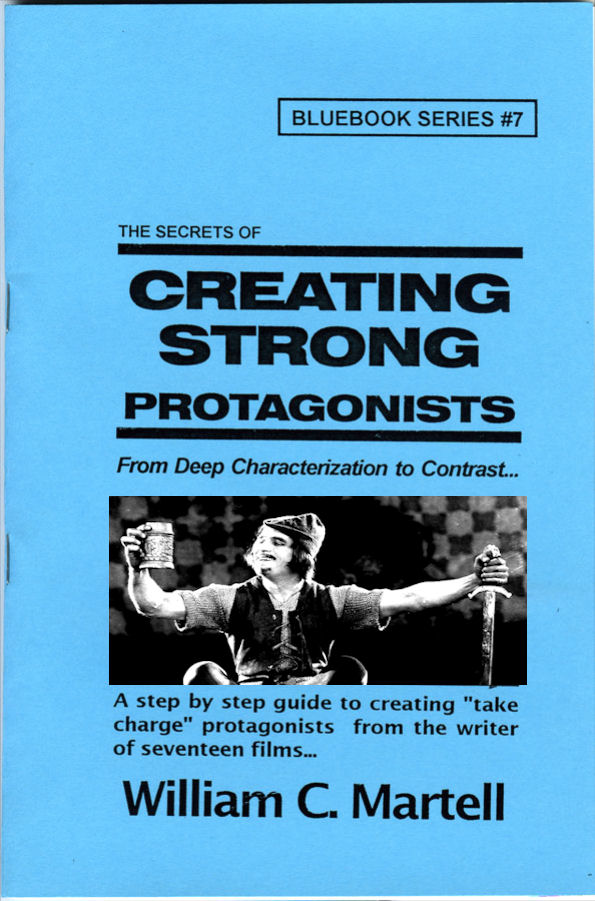
MOVIES ARE CHARACTERS!
*** CREATING STRONG PROTAGONISTS *** - For Kindle!
*** CREATING STRONG PROTAGONISTS *** - For Nook!
Expanded version with more ways to create interesting protagonists! A step-by-step guide to creating "take charge" protagonists. Screenplays are about characters in conflict... characters in emotional turmoil... Strong three dimensional protagonists who can find solutions to their problems in 110 pages. But how do you create characters like this? How do you turn words into flesh and blood? Character issues, Knowing Who Is The Boss, Tapping into YOUR fears, The Naked Character, Pulp Friction, Man With A Plan, Character Arcs, Avoiding Cliche People, Deep Characterization, Problem Protagonists, 12 Ways To Create Likable Protagonists (even if they are criminals), Active vs. Reactive, The Third Dimension In Character, Relationships, Ensemble Scripts, and much, much more. Print version is 48 pages, Kindle version is once again around 205 pages!
ONLY $4.99 - and no postage!
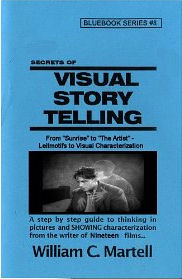
I WRITE PICTURES!
*** VISUAL STORYTELLING *** - For Kindle! (exclusive)
Show Don't Tell - but *how* do you do that? Here are techniques to tell stories visually! Using Oscar Winning Films and Oscar Nominated Films as our primary examples: from the first Best Picture Winner "Sunrise" (1927) to the Oscar Nominated "The Artist" (which takes place in 1927) with stops along the way Pixar's "Up" and Best Original Screenplay Winner "Breaking Away" (a small indie style drama - told visually) as well as "Witness" and other Oscar Winners as examples... plus RISE OF THE PLANET OF THE APES. Print version is 48 pages, Kindle version is over 200 pages!
ONLY $4.99 - and no postage!
DESCRIPTION & VOICE Blue Book!
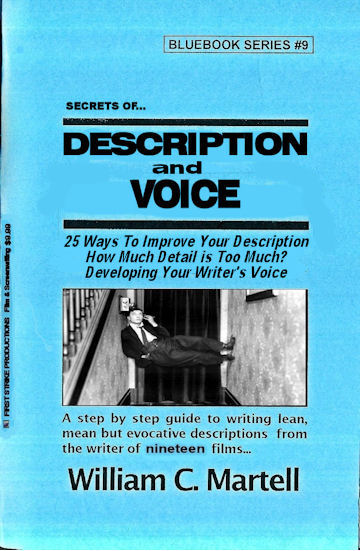
DESCRIPTION & VOICE Blue Book.
IS HALF OF YOUR STORY IN TROUBLE?
Most screenplays are about a 50/50 split between dialogue and description - which means your description is just as important as your dialogue. It just gets less press because the audience never sees it, the same reason why screenwriters get less press than movie stars. But your story will never get to the audience until readers and development executives read your script... so it is a very important factor. Until the movie is made the screenplay is the movie and must be just as exciting as the movie. So how do you make your screenplay exciting to read? Description is important in a novel as well, and the “audience” does read it... how do we write riveting description?
Only $4.99 and no postage!

PRO DIALOGUE TECHNIQUES!
*** DIALOGUE SECRETS *** - For Kindle!
***
Expanded version with more ways to create interesting dialogue! How to remove bad dialogue (and what *is* bad dialogue), First Hand Dialogue, Awful Exposition, Realism, 50 Professional Dialogue Techniques you can use *today*, Subtext, Subtitles, Humor, Sizzling Banter, *Anti-Dialogue*, Speeches, and more. Tools you can use to make your dialogue sizzle! Special sections that use dialogue examples from movies as diverse as "Bringing Up Baby", "Psycho", "Double Indemnity", "Notorious", the Oscar nominated "You Can Count On Me", "His Girl Friday", and many more! Print version is 48 pages, Kindle version is over 175 pages!
Only $4.99 - and no postage!

WHAT IS A SCENE?
*** SCENE SECRETS *** - For Kindle!
***
What is a scene and how many you will need? The difference between scenes and sluglines. Put your scenes on trial for their lives! Using "Jaws" we'll look at beats within a scene. Scene DNA. Creating set pieces and high concept scenes. A famous director talks about creating memorable scenes. 12 ways to create new scenes. Creating unexpected scenes. Use dramatic tension to supercharge your scenes. Plants and payoffs in scenes. Plus transitions and buttons and the all important "flow"... and more! Over 65,000 words! Print version was 48 pages, Kindle version is around 210 pages!
Only $4.99 - and no postage!
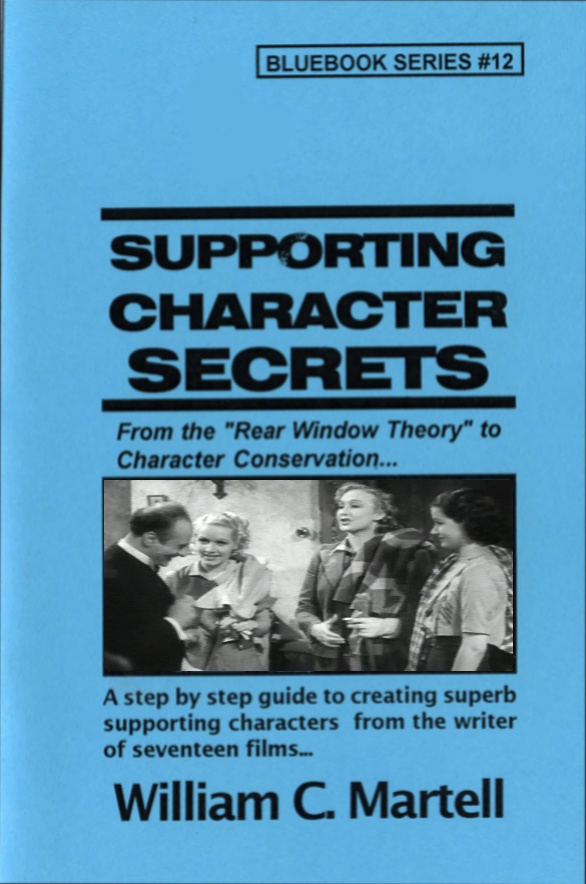
SUBPLOTS?
*** SUPPORTING CHARACTER SECRETS *** - For Kindle! (Exclusive)
Expanded version with more techniques to flesh out your Supporting Characters and make them individuals. Using the hit movie BRIDESMAIDS as well as other comedies like THE HANGOVER and TED and HIGH FIDELITY and
40 YEAR OLD VIRGIN and many other examples we look at ways to make your Supporting Characters come alive on the page.
Print version was 48 pages, Kindle version is around 170 pages!
ONLY $4.99 - and no postage!
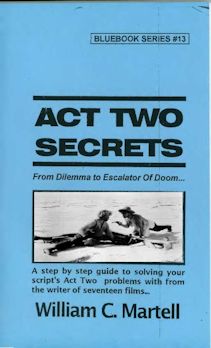
ACT TWO SOLUTIONS!
*** ACT TWO SECRETS *** - For Kindle!
Expanded version with more techniques to help you through the desert of Act Two! Subjects Include: What Is Act Two? Inside Moves, The 2 Ps: Purpose & Pacing, The 4Ds: Dilemma, Denial, Drama and Decision, Momentum, the Two Act Twos, Subplot Prisms, Deadlines, Drive, Levels Of Conflict, Escalation, When Act Two Begins and When Act Two Ends, Scene Order, Bite Sized Pieces, Common Act Two Issues, Plot Devices For Act Two, and dozens of others. Over 67,000 words (that’s well over 200 pages) of tools and techniques to get you through the desert of Act Two alive!
Print version was 48 pages, Kindle version is well over 200 pages!
ONLY $4.99 - and no postage!
All About Endings!
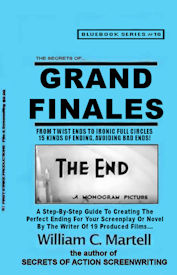
GRAND FINALES Blue Book!
The Perfect Ending For Your Story!
The First Ten Pages Of Your Screenplay Are Critical,
But What About The Last 10 Pages?
Creating the perfect ending to your story! This 100,000 word book shows you how to end your story with a bang, rather than a whimper. Everything from Resolution Order to Act Three Tools to Happy or Sad Endings? to How The Beginning Of Your Story Has Clues To The Ending (in case you were having trouble figuring out how the story should end) to Falling Action to How To Avoid Bad Endings to Writing The Perfect Twist Ending to Setting Up Sequels & Series to Emotional Resolutions to How To Write Post Credit Sequences to Avoiding Deus Ex Machinas, to 20 Different Types Of Ends (and how to write them) and much more! Everything about endings for your screenplay or novel!
Only: $4.99
NO KINDLE REQUIRED! Get the *free* app (any device, except your Mr. Coffee) on the order page on Amazon!
All About LOGLINES, TREATMENTS, and PITCHING!

LOGLINES, TREATMENTS, and PITCHING! Blue Book!
Distilling Your Screenplay!
Loglines, Treatments, Pitching, Look Books, Pitch Decks, One Pagers, Rip-O-Matics?
You have written a brilliant 110 page screenplay, but how do you get anyone to read it? You need to distill it down into some form of verbal moonshine or story rocket fuel that will ignite that bored development executive or manager or agent and get them to request your screenplay. But how do you shrink those 110 pages into a 25 word logline or a 2 minute elevator pitch or a one page synopsis or a short paragraph? This 100,000 word book shows you how! Everything you need to know! From common logline mistakes (and how to solve them) to how your pitch can reveal story problems to the 4 types of pitches!
272 Pages - ONLY $4.99!
READY TO BREAK IN?
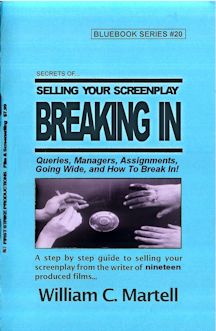
THE BUISINESS SIDE
*** BREAKING IN BLUE BOOK *** - For Kindle!
Should really be called the BUSINESS BLUE BOOK because it covers almost everything you will need to
know for your screenwriting career: from thinking like a producer and learning to speak their language,
to query letters and finding a manager or agent, to making connections (at home and in Hollywood) and
networking, to the different kinds of meetings you are will have at Studios, to the difference between
a producer and a studio, to landing an assignment at that meeting and what is required of you when you
are working under contract, to contracts and options and lawyers and... when to run from a deal!
Information you can use *now* to move your career forward! It's all here in the Biggest Blue Book yet!
Print version was 48 pages, Kindle version is over 400 pages!
$4.99 - and no postage!

Use your creative energy to focus on the content; let Final Draft take care of the style. Final Draft is the number-one selling application specifically designed for writing movie scripts, television episodics and stage plays. Its ease-of-use and time-saving features have attracted writers for almost two decades positioning Final Draft as the Professional Screenwriters Choice. Final Draft power users include Academy, Emmy and BAFTA award winning writers like Oliver Stone, Tom Hanks, Alan Ball, J.J. Abrams, James Cameron and more.
* * * Buy It!
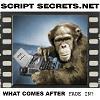
|
|
|
|
|
SECRETS OF ACTION SCREENWRITING
|
|
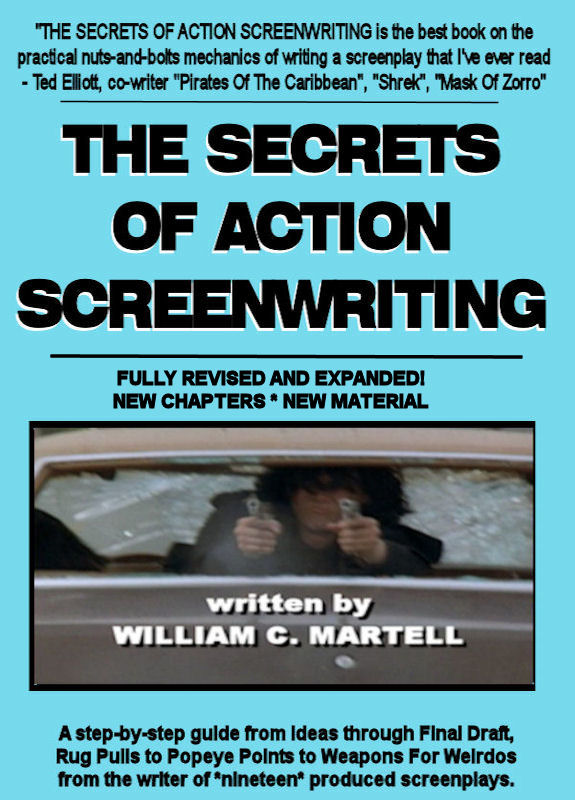 IT'S BACK! SECRETS OF ACTION SCREENWRITING
IT'S BACK! SECRETS OF ACTION SCREENWRITING
Over 460 pages packed with tips and techniques.
How to
write a plot twist,
the four kinds of suspense (and how to create it), reversals, ten ways to invent new action scenes, secrets and lies,
creating the ultimate
villain, five kinds of love interests, MORE! CLICK HERE!
|
|
CLASSES ON MP3
|
|
 CLASSES ON MP3! Take a class on MP3! GUERRILLA MARKETING - NO AGENT? NO PROBLEM! and WRITING THRILLERS (2 MP3s). Full length classes on MP3. Now Available: IDEAS & CREATIVITY, WRITING HORROR, WRITING INDIE FILMS, more!
CLASSES ON MP3! Take a class on MP3! GUERRILLA MARKETING - NO AGENT? NO PROBLEM! and WRITING THRILLERS (2 MP3s). Full length classes on MP3. Now Available: IDEAS & CREATIVITY, WRITING HORROR, WRITING INDIE FILMS, more!
Take classes on MP3!
|
|
MY OTHER SITES
|
|
B MOVIE WORLD
Cult Films, Exploitation, Bikers & Women In Prison, Monster Movies.
FIRST STRIKE PRODUCTIONS
Producing my own scripts, investment possibilities, pipe dreams.
|
|
NAKED SCREENWRITING MP3s
|
|
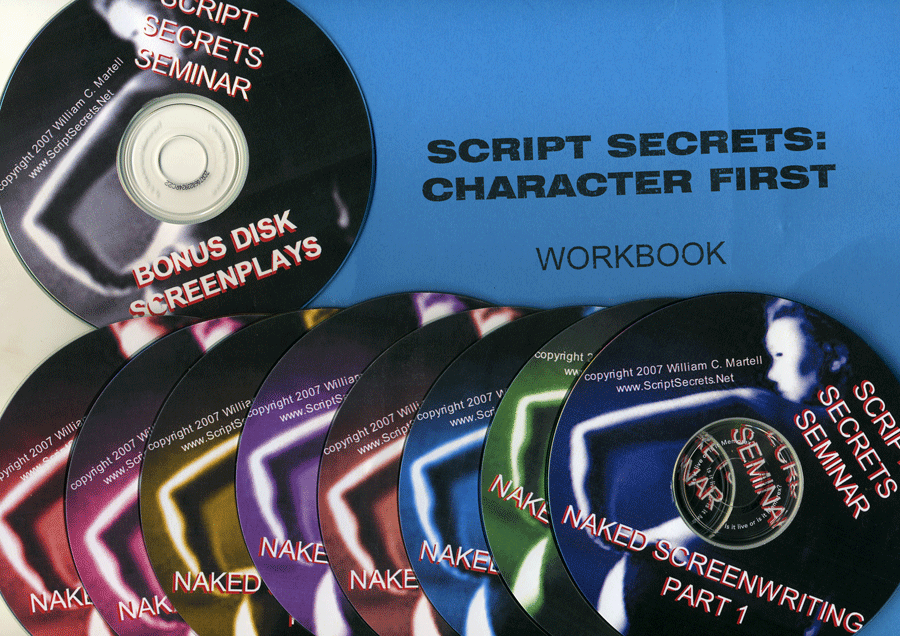 The NAKED SCREENWRITING CLASS ON MP3!
The 2001 London Class on 8 MP3s! Recorded *live* the morning after the Raindance Film Festival
wrapped. The two day class on 8CD worth, plus a workbook, plus a bonus CD.
The NAKED SCREENWRITING CLASS ON MP3!
The 2001 London Class on 8 MP3s! Recorded *live* the morning after the Raindance Film Festival
wrapped. The two day class on 8CD worth, plus a workbook, plus a bonus CD.
The 2 Day Class on MP3!
|
|
ONLINE CLASSES
|
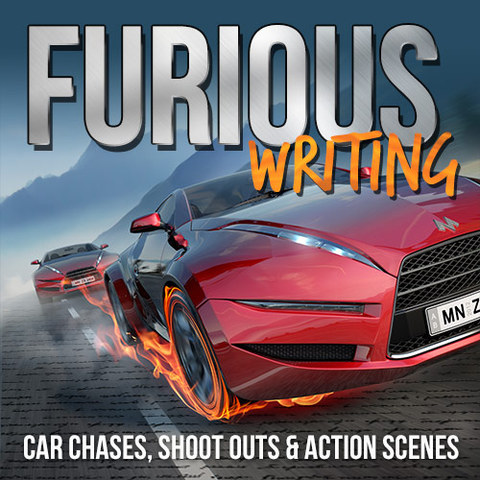
|
|
BILL'S CORNER
|
|
My
nineteen produced films, interviews with me in magazines,
several sample scripts, my available scripts list... And MORE!
...............................BILL'S CORNER
Available Scripts
|
|
E BOOKS PAGE
|
|
 E BOOKS: New Blue Books and Novelettes!
E BOOKS: New Blue Books and Novelettes!
I am expanding all of the Blue Books from around 44 pages of
text to around 200 pages! Some are over 250 pages! See what is availabale and what is coming soon!Also, I've been writing Novelletes and there
will soon be novels.
E BOOKS: BLUE BOOKS & NOVELLETES
|
|
BOOKLETS & PRODUCTS
|
|
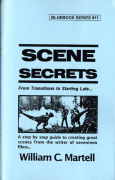 FIRST STRIKE BLUE BOOKS
FIRST STRIKE BLUE BOOKS
Each Blue Book is 48
pages and focuses on a different aspect of screenwriting. Dialogue. Visual Storytelling. Your First Ten Pages. Act 2 Booster. Protagonists. Great Endings.
Seventeen Blue Books now available!
THE SECRETS OF ACTION SCREENWRITING OUT OF PRINT!
|
|
|
|
|

